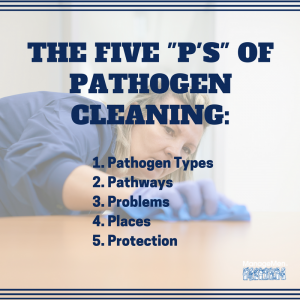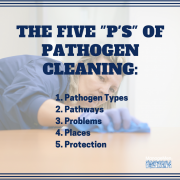The Five P’s of Pathogen Cleaning
As any professional in our industry knows, cleaning isn’t just about removing dirt, but also stopping the spread of bacteria and infection in the buildings we clean. It’s not just about appearance, but also about health—the health of the people in the building and the people cleaning the building.
As we wrap up our safety series for National Safety Month, we’re putting the spotlight on pathogens. More than ever, educating our custodial teams about pathogens—what they are, how they spread and what cleaners can do to protect themselves—has become critical beyond the healthcare world. Cleaners in a variety of public and private settings are regularly exposed to biological hazards that carry risks and responsibilities. Equipping custodial workers with the education they need to effectively clean for health not only empowers them, but will also improve the health of our buildings.
When training custodial teams about pathogens, consider the Five P’s of Pathogens.*
The five P’s include:
- Pathogen types: Broadly speaking, a pathogen is basically anything that can cause disease. Different types of pathogens may include:
- Bacteria: Bacteria are single-celled organisms that can thrive in extreme conditions. They do not require a living host, such as a human being, in order to reproduce. Salmonella, E.coli and MRSA are just a few of the types of bacteria that custodial workers would encounter.
- Viruses: Generally smaller than bacteria, viruses require a living host to reproduce. Viruses are likely to produce an outbreak of illness, such as influenza or the common cold.
- Parasites: Parasites live on or inside a living host. They can cause a variety of issues, including nausea and muscle pain. Examples might include headline or tapeworm, depending on the mode of transmission.
- Fungi: As the name implies, fungi are molds and yeasts that commonly cause respiratory problems in humans.
- Pathways: The primary way a pathogen can enter your body is through inhalation, ingestion (in food or water) or through direct contact with bodily fluids or blood. Custodial workers with c
 uts or abrasions and who do not use protective gloves can be at higher risk of exposure.
uts or abrasions and who do not use protective gloves can be at higher risk of exposure. - Problems: If a pathogen enters the body, it can result in temporary illness to the custodial worker, such as influenza or a cold, to something more dangerous and deadly, like MRSA. Because custodial teams often touch many surfaces in a building, they also have the potential or spreading the pathogen unknowingly, which is why proper hand washing is essential.
- Places: Pathogens can be present on most hard surfaces, but are commonly found on fomites, or high-touch areas, which include light switches, elevator buttons, telephones and door handles. Kitchen areas and restrooms can also provide hospitable environments to pathogens.
- Protection: Wearing the proper personal protective equipment (PPE) is essential based on the potential hazards that may exist. Protective gloves and hand washing between areas can be an effective way to break the chain of infection.
For custodial workers to take pride in what they do, they need to be educated on the importance of their work and recognized for their efforts. We have a quick reference guide to understanding all of the microbiology used in the cleaning industry that you can use in your educational programs. “Microbiology for Cleaning Workers Simplified” offers the basics to help cleaning workers understand the basics of sanitation, vocabulary and the history of cleaning for health. You can check it out here.
*This is by not intended to serve as a comprehensive resource on pathogen cleaning, but a baseline primer you can use to help educate custodial workers.



